
11 minute read
Washing Eyes With Soap
from Spring 2008
By AN Derick Jaramillo
My story is about another simple job gone wrong. We just were washing an airplane; what could go wrong? Yes, I have heard the stories of turco and other people, but this job is easy. I didn’t believe anything could happen to me. I’m smarter than that, and I always wear eye protection…well, almost always.
Advertisement
One evening, my shipmates and I were washing one of our E-2Cs. Everything was going smoothly, and the job was getting done rather quickly.
When we finished, I removed my PPE and started to clean up the area. I was moving a bucket of wash soap out of the way when some of it splashed into my eyes. I immediately ran to the eyewash station to rinse out the soap. I rinsed several times, but the burning did not stop. My vision began to blur badly and my eyes began to swell.
I told my supervisor about my problem, and he told the maintenance-control chief. I was rushed to medical, and they flushed out my eyes several more times before sending me to a hospital off base. When I arrived at the emergency room, I barely could see anything at all. I was admitted and stayed there over night with a saline solution hooked up to my eyes—a very painful process.
In the morning, I went to see a specialist to see if any permanent damage had occurred. Luckily, the diagnosis was favorable, and I wasn’t going to have any longterm side effects. I did, however, receive a prescription medicine to help with the healing. On top of having to take medication for two weeks, my vision was affected for the whole period. It took a while to return to normal. The biggest lesson I learned from the entire experience is that we use PPE for a reason, and it should be worn anytime hazmat is handled. Unfortunately, I had to learn the hard way.
Airman Jaramillo works in the line division at VAW-116.
Hand Taco Tuesday
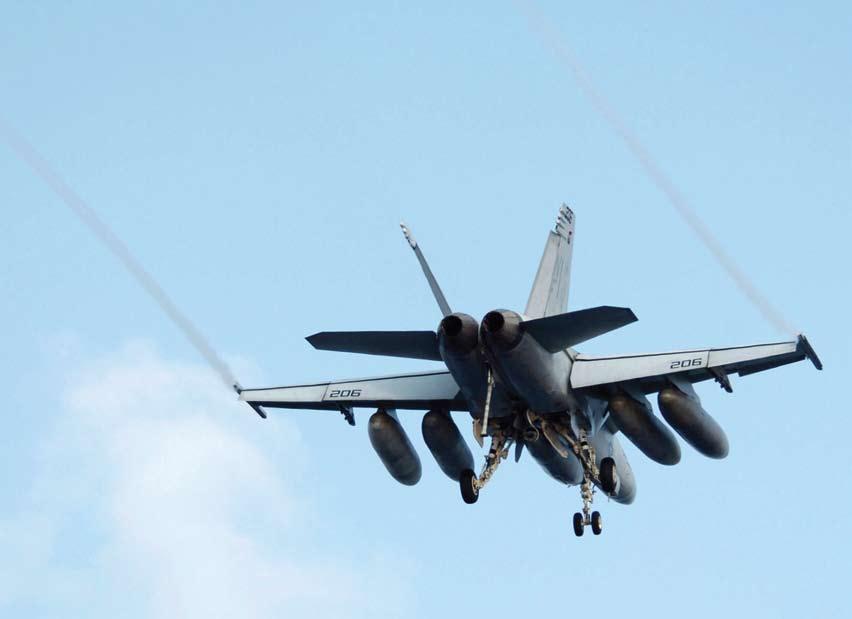
Navy photo by PH3 Jonathan Chandler
By AN Justin Henderson
Iwoke up that Tuesday evening, expecting a normal night at work. A few hours later, I had a safety incident that almost crushed my right hand.
When I got to the shop, I began my typical airman duties: Pre-op some SE gear, carry some toolboxes, hold the flashlight…you know…nothing out of the ordinary. My PO3 then received a phone call from the AOs. They needed some help dropping a 480-gallon tank for inspection. “No big deal,” I thought. “I’ve dropped plenty of tanks.” I didn’t realize at the time how terrible those words sound, even though other maintainers have said them in the past with bad results.
We arrived at the jet in hangar bay No. 2 and found four ordies already there. We had everything needed for the job: a speed-handle, the proper 7/16-inch socket to unlock the BRU, four people—including me—to assist lowering the tank, and an AO1 CDI to drop the tank. We were all set, or so it appeared.
An empty external drop-tank dolly sat on the other side of the jet, between a pallet-jack and some other equipment. Two tractors blocked direct access to the dolly, so we couldn’t get to it as quickly as we would have liked. And it was required for this job.
The tank was dry-hung, meaning it was connected to the wing, but the fuel line was not attached or feeding fuel into the tank. The inspection was a quick job for the AOs, and we had the resources and time to move the gear to get that dolly. However, everyone wanted to get the job done, so we decided to do a manual drop. That means two people carry the forward end of the tank, and two people carry the aft end. One person then unlocks and drops the tank.
Although these photos show an EA-6B, the dip test is valid for all drop-tanks.
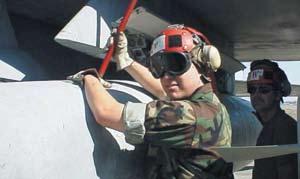
“Thump tests” don’t work, and you can’t always believe gauges. Dip the tank before you try to drop it.

After dipping the tank to make sure it’s empty, be sure the people at both ends of the tank are ready before you release it.
If the man releasing the tank from the bomb rack doesn’t dip the tank first, the Sailors at both ends are going to be holding roughly 2,000 pounds of thump-tested grief.
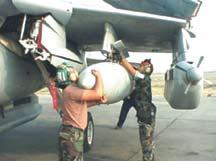
We took up our positions, and I asked the AD3, “Hey, is there any fuel in this tank?” He in turn asked the AOs. After a couple of headshakes, we were ready to drop the tank. It was at that point when I seriously should have considered the gravity (pun intended) of the whole situation and applied some ORM.
AO1 called, “Ready in the back, ready in the front, here comes the weight!” I next heard the telltale click that I’ll never forget. The tank became solid, dead weight. We all lost our grip, and the tank fell to the ground with a wet thud. The tank still had about 200 pounds of fuel inside. We had another problem…my right hand was sandwiched between the non-skid and the bottom of the tank.
At that point, everyone in the hangar bay knew it, too, because I let out a long, horrifying howl. Panicked and in pain, I jerked my hand free of the sandwich that just had turned my hand into a taco. My hand already was swelling, and sharp, knife-like pains tore through my arm. I could feel my bones burning white-hot. As the people around me came to help, I literally was seeing stars.
We all shook off the mistake, secured the tank, and went back to the shop. My hand still was throbbing, though, and I no longer was able to make a fist. The supervisor sent me to medical for an exam.
This simple mistake caused two fractures and a broken piece of bone in my wrist. I now am on light and limitedduty for four to six weeks, with possible surgery in my future. To make matters worse, I increased the workload on my shipmates because our shop now is down a man.
Situations like this happen too often, and it almost always is because of perceived pressure that makes us work to get a job done too quickly. In this case, we really had the time but pushed anyway. Maintainers always have two options: the right way and the wrong way. In this case, we should have asked an ABH to move the tractors for five minutes so we could have gotten the dolly and dropped the tank correctly. It was that simple.
We had the tools and the resources, but we didn’t have the required patience. We also didn’t practice good ORM. At times like this, someone needs to step up and say, “This situation isn’t right” or “Maybe we should try something else” or simply, “This isn’t safe, I’m not doing it.” Nobody is going to think any lesser of you for doing a job the right way.
Airman Henderson works in the mech shop at VFA-27.
A couple other things would have helped: the book, checklist and more importantly, not doing a thump test. Mech has said it 237 times since 1961, the first year Mech came out, a thump test doesn’t work…period. Pop the cap, do a dip check, and stop injuring maintainers.—Ed.
Just a Scrape
By AM2(AW) John Franklin
Ithink everyone has heard what happens when you assume anything. As the saying goes, “You make an ass out of you and me.” It’s a clever saying and is easy to remember. Never did I believe it would apply to me, but one day, it did.
I had been an airframe CDI for a year and never fully understood the responsibility that comes with that position, until my mistake. When a maintainer becomes
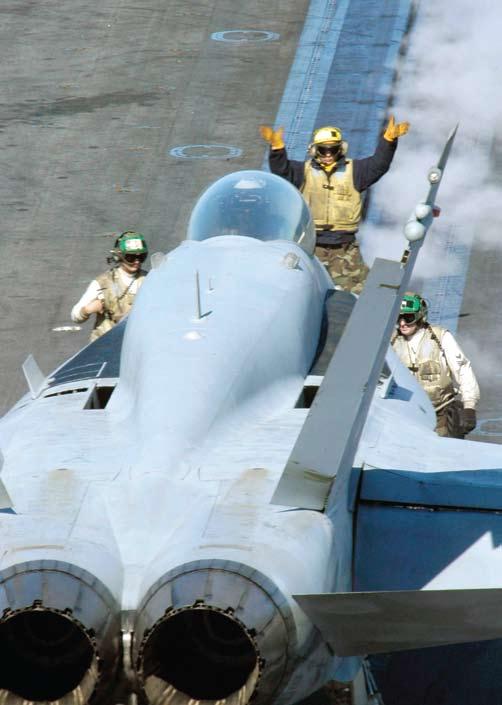
a CDI, their responsibility increases, as does the trust of everyone in the squadron—officer and enlisted. As a CDI, I am responsible for the quality of work done on the jet, making sure it is safe for the pilots who will fly it and capable of achieving its assigned missions. A good general description of a CDI’s responsibilities is that we are an extended arm of QA division.
My story is simple, and my mistake almost cost me the trust of the pilots and maintenance department when I assumed, rather than inspected. I’m a troubleshooter in my squadron and work nights. We were within a week of deploying, and that time can be very hectic at any squadron. Pilots fly a lot of hours and do field carrier-landing practices. Maintainers work hard to give ops enough jets to get all the crews carrier-qualified before we deploy. This week was routine for the troubleshooters, but airframes had an unusually heavy workload. With our flight schedule over and being an airframer, I decided to help them with their workload. They had an aircraft on jacks to service the struts and to comply with a recent technical directive (TD). While helping with the struts and the TD, we found more work. All the tires and brakes were worn. They were within limits, but, this close to deployment, we decided to take advantage of the aircraft being on jacks and change them. I began to feel the burden of all the maintenance done that evening, both with airframes and troubleshooters. I don’t mean to say I couldn’t handle both jobs, but somewhere during the night, I failed to stay aware of all the work. The worn tires and brakes had been pulled off and turned in, and we were waiting for the new ones to arrive. Once they came in, I took them to the aircraft.
Gouge on the leading edge of the stab. Notice the bare metal, length and depth of the gouge.
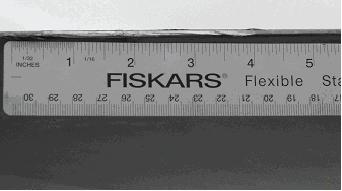
Bottom and leading edge of the stab. Notice the paint damage in the center of the picture.

At that same time, one of our PCs came to me and told me of a gripe on the aircraft. He said the aircraft had a scratch on the horizontal stab. Of course, a scratch can mean many things, from chipped paint to a gouge or just a mark on the jet. Hornets often have paint damage on the stabs, and this is what I thought the PC was referring to.
Using what turned out to be terrible judgment, I told the PC not to worry about the scratch and continued to work on the jacked aircraft.
The scratch turned out to be a gouge in the aluminum section on the leading edge of the stab. Once the damage was inspected, we found it was not within limits, meaning the stab should have been repaired or replaced. This type of damage has very small limitations (< .0030-inch on the leading edge). A quick visual inspection wouldn’t have told me that the damage wasn’t within limits, but it would have forced me to question the damage and look up the limitations in the structuralrepair manual. Damage to the leading edge of the stab, a primary flight-control surface, could lead to abnormal flight conditions, thus compromising the safety of the pilot.
I consider myself a hard-working and competent airframer. PCs come to me when they find something wrong with the jets. Almost always—99.9 percent of the time—I investigate the problem and determine what to do. This time, I didn’t, and the experience taught me that every situation that comes up is unique. Just because a scratch sometimes turns out to be nothing doesn’t mean it always will be that way. I should have told the PC to write a MAF, and then I or another qualified airframer would have looked at it before the next flight. This one step would have prevented us from flying a down aircraft.
I also could have asked how the stab was “scratched.” As it turns out, the stab was damaged when the aft section of the FLIR pod dislodged in flight and hit the leading edge of the stab. Had I investigated the report of a scratch and examined the surrounding area, I would have noticed this section missing and realized where the damage had come from.
The Naval Safety Center gives maintainers a good analogy to explain how mishaps occur; they call it the “Swiss Cheese” model or theory. This approach states that, for a mishap to occur, all the holes in the Swiss cheese have to line up. I had an opportunity to block one of those holes but missed my chance. Luckily, no mishap occurred.
The holes lined up this time when I assumed the damage was negligible and when the damage was missed during the FLIR daily walk around of the jets the following morning, and pre-flight inspection. After the aircraft went flying and returned safely, the squadron was fortunate that the holes finally were blocked after a post-flight inspection.
This simple mistake endangered the safety of a jet and life of a pilot, and it nearly caused my co-workers and management to lose faith in my abilities. Had I taken just five minutes to grab a flashlight and examine the stab, I would have noticed the damage and would have realized it wasn’t normal.
The stab was removed and repaired after only one flight. It’s unfortunate that it took an incident like this one to open my eyes, but it shows how one person not taking each situation seriously could lead to an aircraft mishap. I have learned a great deal from this event. I now investigate the problem 100 percent of the time and determine what to do. I also have rebuilt the confidence of leadership in my abilities.
Petty Officer Franklin was a troubleshooter with VFA-34 when he wrote this story.





